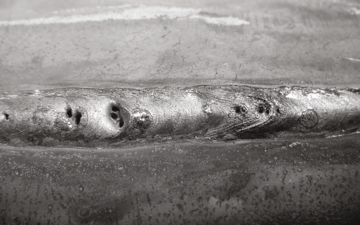Recognizing What is Porosity in Welding: Causes and Solutions
Recognizing What is Porosity in Welding: Causes and Solutions
Blog Article
Understanding Porosity in Welding: Discovering Causes, Effects, and Prevention Techniques
Porosity in welding is a consistent challenge that can dramatically affect the quality and stability of welds. As experts in the welding market are well mindful, comprehending the causes, impacts, and prevention strategies associated with porosity is important for accomplishing robust and reliable welds. By diving into the origin creates of porosity, analyzing its harmful impacts on weld high quality, and checking out reliable prevention techniques, welders can enhance their understanding and skills to produce high-quality welds constantly. The detailed interplay of factors adding to porosity needs an extensive understanding and an aggressive strategy to ensure effective welding outcomes.
Common Reasons of Porosity
Porosity in welding is mainly created by a combination of variables such as contamination, improper securing, and poor gas insurance coverage during the welding procedure. Contamination, in the kind of dirt, grease, or rust on the welding surface area, develops gas pockets when heated up, resulting in porosity in the weld. Incorrect protecting happens when the protecting gas, commonly made use of in processes like MIG and TIG welding, is incapable to totally secure the molten weld pool from responding with the surrounding air, resulting in gas entrapment and succeeding porosity. Additionally, poor gas insurance coverage, typically due to incorrect circulation rates or nozzle positioning, can leave parts of the weld unguarded, enabling porosity to form. These variables jointly add to the development of gaps within the weld, damaging its stability and possibly triggering architectural problems. Recognizing and resolving these typical reasons are vital steps in stopping porosity and making certain the high quality and strength of welded joints.
Effects on Weld High Quality
The visibility of porosity in a weld can considerably endanger the general quality and honesty of the bonded joint. Porosity within a weld develops spaces or cavities that weaken the framework, making it a lot more vulnerable to cracking, corrosion, and mechanical failure.
Furthermore, porosity can impede the effectiveness of non-destructive testing (NDT) strategies, making it challenging to discover other flaws or discontinuities within the weld. This can bring about significant safety and security worries, specifically in crucial applications where the structural stability of the welded elements is critical.

Prevention Techniques Summary
Given the detrimental effect of porosity on weld top quality, effective avoidance methods are vital to preserving the structural honesty of welded joints. Among the primary prevention strategies is extensive cleaning of the base products before welding. Contaminants such as oil, grease, corrosion, and dampness can add to porosity, so use this link making certain a clean job surface is important. Appropriate storage of welding consumables in completely dry conditions is additionally important to prevent moisture absorption, which can lead to gas entrapment throughout welding. Furthermore, selecting the proper welding parameters, such as voltage, current, and travel speed, can help lessen the risk of porosity formation. Ensuring sufficient shielding gas flow and protection is an additional vital prevention strategy, as insufficient gas protection can cause atmospheric contamination and porosity. Lastly, proper welder training and qualification are essential for executing precautionary actions properly and constantly. By including these prevention techniques into welding practices, the event of porosity can be dramatically reduced, leading to stronger and a lot more trustworthy welded joints.
Significance of Proper Shielding
Correct securing in welding plays a crucial role in protecting against climatic contamination and guaranteeing the stability of bonded joints. Shielding gases, such as argon, helium, or a mixture of both, are generally utilized to safeguard the weld swimming pool from responding with components airborne like oxygen and nitrogen. When these reactive elements enter into call with the hot weld swimming pool, they can create porosity, resulting in weak welds with decreased mechanical residential properties.

Insufficient shielding can lead to different defects like porosity, spatter, and oxidation, endangering the architectural integrity of the bonded joint. Adhering to proper shielding practices is essential to create high-grade welds with marginal issues and guarantee the long life and you can check here integrity of the welded components.
Tracking and Control Methods
Exactly how can welders successfully keep track of and regulate the welding procedure to ensure optimum outcomes and avoid defects like porosity? One key method is with using advanced surveillance technologies. These can consist of real-time tracking systems that provide responses on criteria such as voltage, present, travel rate, and gas circulation rates. By continually keeping track of these variables, welders can determine inconsistencies from the optimal conditions and make immediate adjustments to prevent porosity development.

Additionally, carrying out proper training programs for welders is crucial for keeping track of and managing the welding procedure successfully. What is Porosity. Educating welders on the relevance of preserving constant parameters, such as proper gas shielding and take a trip speed, can assist avoid porosity problems. Normal analyses and qualifications can also make certain that welders excel in monitoring and regulating welding processes
Additionally, making use of automated welding systems can boost surveillance and control capabilities. These systems can exactly manage welding criteria, reducing the likelihood of human mistake and making websites sure consistent weld quality. By integrating innovative tracking technologies, training programs, and automated systems, welders can efficiently monitor and regulate the welding procedure to minimize porosity flaws and accomplish high-grade welds.
Final Thought

Report this page